Yixiao Wang
UoB-NLP at SemEval-2025 Task 11: Leveraging Adapters for Multilingual and Cross-Lingual Emotion Detection
Apr 11, 2025Abstract:Emotion detection in natural language processing is a challenging task due to the complexity of human emotions and linguistic diversity. While significant progress has been made in high-resource languages, emotion detection in low-resource languages remains underexplored. In this work, we address multilingual and cross-lingual emotion detection by leveraging adapter-based fine-tuning with multilingual pre-trained language models. Adapters introduce a small number of trainable parameters while keeping the pre-trained model weights fixed, offering a parameter-efficient approach to adaptation. We experiment with different adapter tuning strategies, including task-only adapters, target-language-ready task adapters, and language-family-based adapters. Our results show that target-language-ready task adapters achieve the best overall performance, particularly for low-resource African languages with our team ranking 7th for Tigrinya, and 8th for Kinyarwanda in Track A. In Track C, our system ranked 3rd for Amharic, and 4th for Oromo, Tigrinya, Kinyarwanda, Hausa, and Igbo. Our approach outperforms large language models in 11 languages and matches their performance in four others, despite our models having significantly fewer parameters. Furthermore, we find that adapter-based models retain cross-linguistic transfer capabilities while requiring fewer computational resources compared to full fine-tuning for each language.
Physics-Aware Robotic Palletization with Online Masking Inference
Feb 19, 2025Abstract:The efficient planning of stacking boxes, especially in the online setting where the sequence of item arrivals is unpredictable, remains a critical challenge in modern warehouse and logistics management. Existing solutions often address box size variations, but overlook their intrinsic and physical properties, such as density and rigidity, which are crucial for real-world applications. We use reinforcement learning (RL) to solve this problem by employing action space masking to direct the RL policy toward valid actions. Unlike previous methods that rely on heuristic stability assessments which are difficult to assess in physical scenarios, our framework utilizes online learning to dynamically train the action space mask, eliminating the need for manual heuristic design. Extensive experiments demonstrate that our proposed method outperforms existing state-of-the-arts. Furthermore, we deploy our learned task planner in a real-world robotic palletizer, validating its practical applicability in operational settings.
DexHandDiff: Interaction-aware Diffusion Planning for Adaptive Dexterous Manipulation
Dec 11, 2024Abstract:Dexterous manipulation with contact-rich interactions is crucial for advanced robotics. While recent diffusion-based planning approaches show promise for simpler manipulation tasks, they often produce unrealistic ghost states (e.g., the object automatically moves without hand contact) or lack adaptability when handling complex sequential interactions. In this work, we introduce DexHandDiff, an interaction-aware diffusion planning framework for adaptive dexterous manipulation. DexHandDiff models joint state-action dynamics through a dual-phase diffusion process which consists of pre-interaction contact alignment and post-contact goal-directed control, enabling goal-adaptive generalizable dexterous manipulation. Additionally, we incorporate dynamics model-based dual guidance and leverage large language models for automated guidance function generation, enhancing generalizability for physical interactions and facilitating diverse goal adaptation through language cues. Experiments on physical interaction tasks such as door opening, pen and block re-orientation, and hammer striking demonstrate DexHandDiff's effectiveness on goals outside training distributions, achieving over twice the average success rate (59.2% vs. 29.5%) compared to existing methods. Our framework achieves 70.0% success on 30-degree door opening, 40.0% and 36.7% on pen and block half-side re-orientation respectively, and 46.7% on hammer nail half drive, highlighting its robustness and flexibility in contact-rich manipulation.
DexDiffuser: Interaction-aware Diffusion Planning for Adaptive Dexterous Manipulation
Nov 27, 2024Abstract:Dexterous manipulation with contact-rich interactions is crucial for advanced robotics. While recent diffusion-based planning approaches show promise for simpler manipulation tasks, they often produce unrealistic ghost states (e.g., the object automatically moves without hand contact) or lack adaptability when handling complex sequential interactions. In this work, we introduce DexDiffuser, an interaction-aware diffusion planning framework for adaptive dexterous manipulation. DexDiffuser models joint state-action dynamics through a dual-phase diffusion process which consists of pre-interaction contact alignment and post-contact goal-directed control, enabling goal-adaptive generalizable dexterous manipulation. Additionally, we incorporate dynamics model-based dual guidance and leverage large language models for automated guidance function generation, enhancing generalizability for physical interactions and facilitating diverse goal adaptation through language cues. Experiments on physical interaction tasks such as door opening, pen and block re-orientation, and hammer striking demonstrate DexDiffuser's effectiveness on goals outside training distributions, achieving over twice the average success rate (59.2% vs. 29.5%) compared to existing methods. Our framework achieves 70.0% success on 30-degree door opening, 40.0% and 36.7% on pen and block half-side re-orientation respectively, and 46.7% on hammer nail half drive, highlighting its robustness and flexibility in contact-rich manipulation.
DeSiRe-GS: 4D Street Gaussians for Static-Dynamic Decomposition and Surface Reconstruction for Urban Driving Scenes
Nov 18, 2024



Abstract:We present DeSiRe-GS, a self-supervised gaussian splatting representation, enabling effective static-dynamic decomposition and high-fidelity surface reconstruction in complex driving scenarios. Our approach employs a two-stage optimization pipeline of dynamic street Gaussians. In the first stage, we extract 2D motion masks based on the observation that 3D Gaussian Splatting inherently can reconstruct only the static regions in dynamic environments. These extracted 2D motion priors are then mapped into the Gaussian space in a differentiable manner, leveraging an efficient formulation of dynamic Gaussians in the second stage. Combined with the introduced geometric regularizations, our method are able to address the over-fitting issues caused by data sparsity in autonomous driving, reconstructing physically plausible Gaussians that align with object surfaces rather than floating in air. Furthermore, we introduce temporal cross-view consistency to ensure coherence across time and viewpoints, resulting in high-quality surface reconstruction. Comprehensive experiments demonstrate the efficiency and effectiveness of DeSiRe-GS, surpassing prior self-supervised arts and achieving accuracy comparable to methods relying on external 3D bounding box annotations. Code is available at \url{https://github.com/chengweialan/DeSiRe-GS}
Imagined Potential Games: A Framework for Simulating, Learning and Evaluating Interactive Behaviors
Nov 06, 2024Abstract:Interacting with human agents in complex scenarios presents a significant challenge for robotic navigation, particularly in environments that necessitate both collision avoidance and collaborative interaction, such as indoor spaces. Unlike static or predictably moving obstacles, human behavior is inherently complex and unpredictable, stemming from dynamic interactions with other agents. Existing simulation tools frequently fail to adequately model such reactive and collaborative behaviors, impeding the development and evaluation of robust social navigation strategies. This paper introduces a novel framework utilizing distributed potential games to simulate human-like interactions in highly interactive scenarios. Within this framework, each agent imagines a virtual cooperative game with others based on its estimation. We demonstrate this formulation can facilitate the generation of diverse and realistic interaction patterns in a configurable manner across various scenarios. Additionally, we have developed a gym-like environment leveraging our interactive agent model to facilitate the learning and evaluation of interactive navigation algorithms.
MobA: A Two-Level Agent System for Efficient Mobile Task Automation
Oct 17, 2024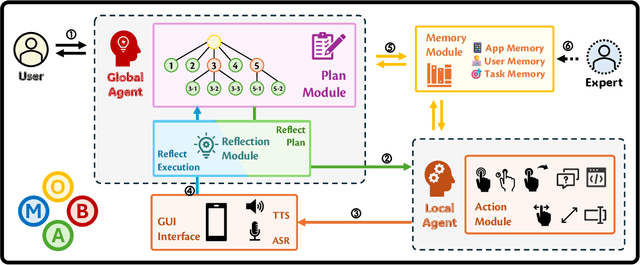
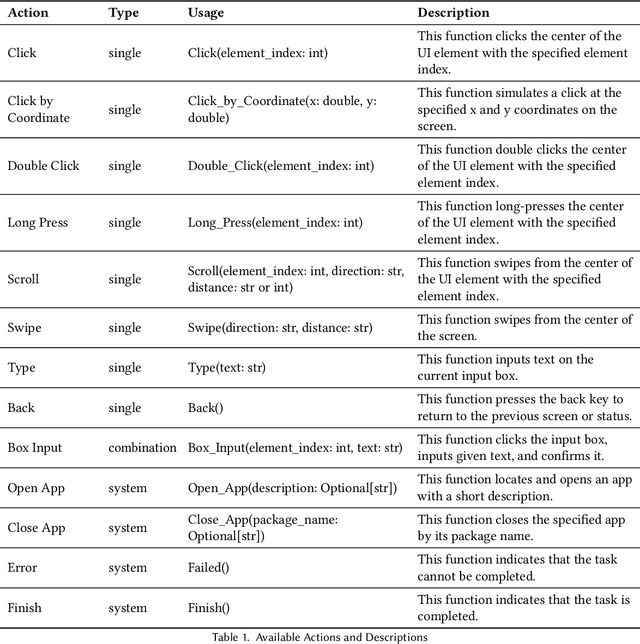

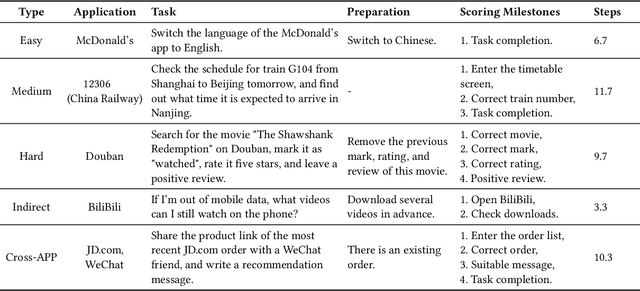
Abstract:Current mobile assistants are limited by dependence on system APIs or struggle with complex user instructions and diverse interfaces due to restricted comprehension and decision-making abilities. To address these challenges, we propose MobA, a novel Mobile phone Agent powered by multimodal large language models that enhances comprehension and planning capabilities through a sophisticated two-level agent architecture. The high-level Global Agent (GA) is responsible for understanding user commands, tracking history memories, and planning tasks. The low-level Local Agent (LA) predicts detailed actions in the form of function calls, guided by sub-tasks and memory from the GA. Integrating a Reflection Module allows for efficient task completion and enables the system to handle previously unseen complex tasks. MobA demonstrates significant improvements in task execution efficiency and completion rate in real-life evaluations, underscoring the potential of MLLM-empowered mobile assistants.
Optimizing Diffusion Models for Joint Trajectory Prediction and Controllable Generation
Aug 01, 2024



Abstract:Diffusion models are promising for joint trajectory prediction and controllable generation in autonomous driving, but they face challenges of inefficient inference steps and high computational demands. To tackle these challenges, we introduce Optimal Gaussian Diffusion (OGD) and Estimated Clean Manifold (ECM) Guidance. OGD optimizes the prior distribution for a small diffusion time $T$ and starts the reverse diffusion process from it. ECM directly injects guidance gradients to the estimated clean manifold, eliminating extensive gradient backpropagation throughout the network. Our methodology streamlines the generative process, enabling practical applications with reduced computational overhead. Experimental validation on the large-scale Argoverse 2 dataset demonstrates our approach's superior performance, offering a viable solution for computationally efficient, high-quality joint trajectory prediction and controllable generation for autonomous driving. Our project webpage is at https://yixiaowang7.github.io/OptTrajDiff_Page/.
Sparse Diffusion Policy: A Sparse, Reusable, and Flexible Policy for Robot Learning
Jul 01, 2024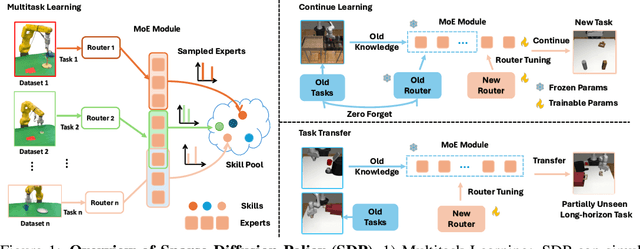

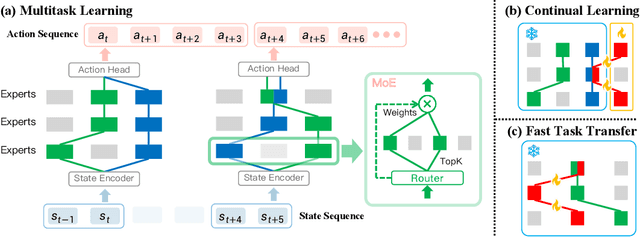

Abstract:The increasing complexity of tasks in robotics demands efficient strategies for multitask and continual learning. Traditional models typically rely on a universal policy for all tasks, facing challenges such as high computational costs and catastrophic forgetting when learning new tasks. To address these issues, we introduce a sparse, reusable, and flexible policy, Sparse Diffusion Policy (SDP). By adopting Mixture of Experts (MoE) within a transformer-based diffusion policy, SDP selectively activates experts and skills, enabling efficient and task-specific learning without retraining the entire model. SDP not only reduces the burden of active parameters but also facilitates the seamless integration and reuse of experts across various tasks. Extensive experiments on diverse tasks in both simulations and real world show that SDP 1) excels in multitask scenarios with negligible increases in active parameters, 2) prevents forgetting in continual learning of new tasks, and 3) enables efficient task transfer, offering a promising solution for advanced robotic applications. Demos and codes can be found in https://forrest-110.github.io/sparse_diffusion_policy/.
A WT-ResNet based fault diagnosis model for the urban rail train transmission system
Jun 10, 2024Abstract:This study presents a novel fault diagnosis model for urban rail transit systems based on Wavelet Transform Residual Neural Network (WT-ResNet). The model integrates the advantages of wavelet transform for feature extraction and ResNet for pattern recognition, offering enhanced diagnostic accuracy and robustness. Experimental results demonstrate the effectiveness of the proposed model in identifying faults in urban rail trains, paving the way for improved maintenance strategies and reduced downtime.
 Add to Chrome
Add to Chrome Add to Firefox
Add to Firefox Add to Edge
Add to Edge